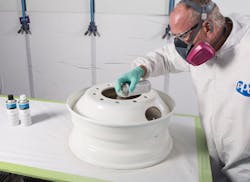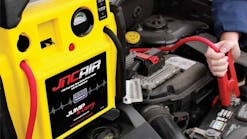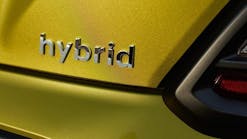Given the competitive environment of today’s commercial fleets, every step a fleet manager takes to keep trucks looking good, running well and staying on the road has to be considered in terms of cost and benefit. Keep trucks properly maintained and working, and the associated expenses can be viewed as an investment to enhance a business’s bottom line. Still, no fleet manager wants to incur unnecessary costs.
Routine scheduled maintenance, regular inspections and prompt efficient repairs of mechanical problems are obvious keys to keeping costs down. That’s standard fleet operating procedure. One area often overlooked, however, is wheels. While tires deservedly get a lot of attention, wheels also help carry that load. True, wheels aren’t as subject to wear and damage as tires, but they still get rusty and corroded from contact with dirt, deicing chemicals, road tar and other debris. Corroded wheels are often equated with safety issues. They need to be maintained properly and refurbished or replaced before corrosion compromises their structural integrity and leads to breakdowns — or worse. In fact, since the early 1990s, OSHA has mandated wheel and rim refurbishing for commercial vehicles. The question becomes how to correctly refurbish wheels without blowing the budget.
Most fleets outsource wheels for refurbishing. While the cost and quality of the refurbishing varies from supplier to supplier, outsourcing is not a bad solution if the cost and work quality are acceptable. The multistep refurbishing process involves abrading or blasting the wheel to remove rust and dirt, pretreating it, powder coating it and finally baking it in a dedicated booth — not a traditional paint booth, due to the high temperatures required — or conveyor oven. This can take several days, a week or even longer. Depending on how many replacement wheels are carried in a fleet’s parts inventory, a truck can be off the road far too long while its wheels are being refurbished. The cost and time involved in outsourcing can be counter-productive.
Another option is to refurbish in-house. A complex option? Not necessarily. There are now aerosol products on the market that allow wheels to be refurbished in a fleet’s own repair facility. One affordable solution that quickly delivers consistent quality and doesn’t require a paint booth comes from PPG’s commercial coatings business. The process involves four simple steps:
- Abrading the wheel surface to remove corrosion.
- Cleaning the wheel with PPG ONECHOICE SXA330 Wax and Grease Remover.
- Applying three double wet coats of PPG CPC-SP8150 gray primer, allowing it to flash for 15 minutes between coats.
- Applying two wet coats of PPG CPC-SP8047 (white) or CPC-SP8050 (black) topcoat and allowing it to flash for 15 minutes between coats.
“The idea behind our refurbishing process is to help fleets keep costs manageable and minimize downtime by doing the job in-house,” said J.J. Wirth, PPG brand manager, commercial coatings U.S. and Canada. “Fleets need to be cost-conscious to compete, but being cost-conscious doesn’t mean skimping on maintenance or settling for less than the proper way of doing things. This PPG process works very well, giving fleets the opportunity to do the job efficiently in their own facilities and save time, trouble and money.”
Wirth further points out that corroded wheels can have an impact beyond maintenance. “Rusty, dirty wheels are not a plus. Your truck’s appearance says something about your brand. Trucks are rolling billboards for their companies, and if a truck doesn’t look good, what does that say about the company? Aesthetics mean something and wheels stand out; look at all the instantly recognizable fleet trucks on the road — Penske, J.B. Hunt and Werner Enterprises are just a few examples. While our process generally offers a white or black topcoat option, we can also create custom colors to match a fleet’s look. And the refurbishing can still be done in-house.”
With time-saving, affordable refurbishing options now available, trucks waste no time in getting back on the road and rolling up the profits.
Information provided by: PPG Industries


